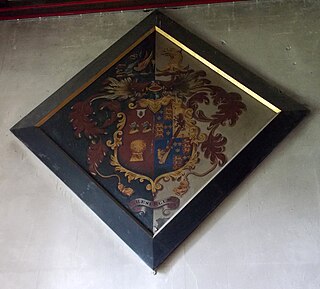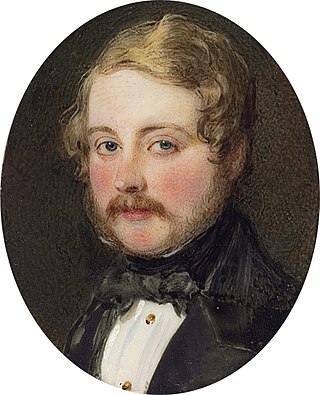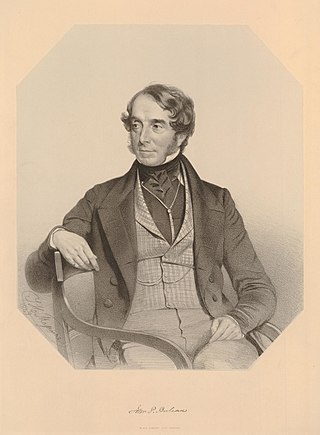
Sir William Baillie of Polkemmet, 2nd Baronet, DL (2 February 1816 – 21 July 1890) [1] was a Scottish oarsman and Conservative [2] politician who sat in the British House of Commons between 1845 and 1847.

Sir William Baillie of Polkemmet, 2nd Baronet, DL (2 February 1816 – 21 July 1890) [1] was a Scottish oarsman and Conservative [2] politician who sat in the British House of Commons between 1845 and 1847.
Born in Edinburgh, he was the eldest son of Sir William Baillie, 1st Baronet and his wife Mary Lyon Dennistoun, the youngest daughter of James Dennistoun. [3] Baillie was educated at Eton College and then at Christ Church, Oxford, where he graduated with a Bachelor of Arts degree in 1836. [4]
While at Oxford, he rowed in the Oxford eight in the second Boat Race which was held in 1836, when Cambridge won. [5] He was also a part of the Head of the River crew at Oxford with his college boat, Christ Church.
Baillie served as captain in the Midlothian Yeomanry Cavalry, [3] and was Lieutenant-Colonel commanding the Edinburgh City Artillery from 1866 to 1884. [6] [7] In 1845 he was elected Member of Parliament for Linlithgowshire, sitting for the next two years. [8] Baillie was a Deputy Lieutenant of Linlithgowshire from 1850 and was a Justice of the Peace. [3]
In 1878 he was the honorary commander of the City Artillery Volunteer Corps based at 27 Cockburn Street, Edinburgh. [9]
On 14 April 1846, Baillie married Mary Stewart, the eldest daughter of Stair Hathorn Stewart. [10] In 1854, he succeeded his father as baronet, [4] and when Baillie died childless in 1890, he was succeeded in the baronetcy by his nephew George. [10]

Marquess of Linlithgow, in the County of Linlithgow or West Lothian, is a title in the Peerage of the United Kingdom. It was created on 23 October 1902 for John Hope, 7th Earl of Hopetoun. The current holder of the title is Adrian Hope.

Earl of Cottenham, of Cottenham in the County of Cambridge, is a title in the Peerage of the United Kingdom. It was created in 1850 for the prominent lawyer and Whig politician Charles Pepys, 1st Baron Cottenham. ) He served as Lord Chancellor from 1836 to 1841 and from 1846 to 1850. Pepys had already been created Baron Cottenham, of Cottenham in the County of Cambridge, in 1836, and was made Viscount Crowhurst, of Crowhurst in the County of Surrey, at the same time he was given the earldom. These titles are also in the Peerage of the United Kingdom. The viscountcy is used as a courtesy title for the Earl's eldest son and heir apparent.

William Bingham Baring, 2nd Baron Ashburton, was a British businessman and a Whig politician who later became a Tory.

The Heathcoat-Amory baronetcy, of Knightshayes Court in Tiverton in the County of Devon, is a title in the Baronetage of the United Kingdom. It was created on 21 March 1874 for John Heathcoat-Amory, a businessman and Liberal politician. Born as John Amory, he was the maternal grandson of John Heathcoat and assumed by Royal licence the additional surname of Heathcoat. The baronetcy descended from father to son until the 1972 death of his grandson, the third Baronet. The latter was succeeded by his younger brother, the fourth Baronet, who was a Conservative politician. In 1960, twelve years before he succeeded to the baronetcy, he was raised to the Peerage of the United Kingdom as Viscount Amory, of Tiverton in the County of Devon. Lord Amory was unmarried and on his death in 1981, the viscountcy became extinct. He was succeeded in the baronetcy by his younger brother, William, the fifth Baronet. The title is currently held by the latter's eldest son, the sixth Baronet, who succeeded in 1982.
There have been three baronetcies created for persons with the surname Baillie, one in the Baronetage of Nova Scotia and two in the Baronetage of the United Kingdom. As of 2014 one creation is extant.
There has been one baronetcy granted to the Lauder family. The baronetcy of Lauder of Fountainhall, Haddingtonshire, was created for John Lauder, last surviving male representative of the Lauders of that Ilk, a rich merchant-burgess and sometime Treasurer and baillie of the City of Edinburgh Council, and an armiger. He purchased the estate of Newington, Edinburgh, and subsequently the lands of Woodhead and Templehall near Pencaitland, which along with others in Edinburghshire and Haddingtonshire, were erected by Crown charter into the feudal barony of Fountainhall on 13 August 1681.
Robert Otway-Cave, styled The Honourable from 1839, was an Irish aristocrat and British politician.
Sir Arthur Edward Middleton, M.P., 7th Baronet was a British MP for the City of Durham.
Sir William Abdy, 7th Baronet was a British politician and baronet.

Sir Richard Warwick Bampfylde, 4th Baronet of Poltimore, North Molton, Warleigh, Tamerton Foliot and Copplestone in Devon and of Hardington in Somerset, England, was Member of Parliament for Exeter (1743–47) and for Devonshire (1747–76).
Sir David Carnegie of Pitarrow, 4th Baronet FRS FRSE was a Scottish politician and 7th Earl of Southesk, 7th Baron Carnegie of Kinnaird and 7th Baron Carnegie, of Kinnaird and Leuchars.

There have been two baronetcies created for persons with the surname Head, one in the Baronetage of England and one in the Baronetage of the United Kingdom. One creation is extant as of 2007.
Sir David Baird, 2nd Baronet, of Newbyth was a British baronet and captain in the British army.
Henry de la Poer Beresford, 2nd Marquess of Waterford, KP, PC (Ire) styled Lord Le Poer from 1783 until 1789 and Earl of Tyrone from 1789 to 1800, was an Irish peer.

Sir Montague John Cholmeley, 2nd Baronet was a British Liberal Party politician and baronet.
Sir James Carnegie of Pittarrow, 3rd Baronet was a Scottish politician, soldier and 6th Earl of Southesk, 6th Baron Carnegie of Kinnaird and 6th Baron Carnegie, of Kinnaird and Leuchars.

Sir Henry Hervey Bruce, 3rd Baronet PC (Ire) was an Irish Conservative politician. He was Member of Parliament for Coleraine from 1862 to 1874, and from 1880 to 1885.

Sir John Peter Boileau, 1st Baronet FRS, DL, JP was a British baronet and archaeologist.
The Dick baronetcy in Prestonfield, Edinburgh was created in the Baronetage of Nova Scotia for James Dick. Initially created in 1677, it was renewed in 1707 and merged with the Cunningham of Lambrughton, Ayrshire baronetcy in 1829. The family seat was Prestonfield House, Edinburgh. Sir William Dick, 2nd Baronet and Sir Alexander Dick, 3rd Baronet were the younger sons of Sir William Cunningham, 2nd Baronet and his wife Janet Dick, the daughter and heiress of Sir James Dick, 1st Baronet. Both brothers changed their surname to Dick on inheriting Prestonfield in turn.
Sir James Graham, 1st Baronet was a British Tory politician.
{{cite web}}: CS1 maint: unfit URL (link){{cite web}}: CS1 maint: unfit URL (link)